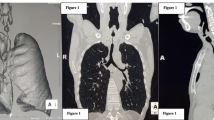Abstract
Prolonged ventilation remains the most common cause of tracheal stenosis. Tracheal reconstruction is the gold standard treatment in these cases. The success of surgery is based on results of the pulmonary function test (PFT) which relies on patients’ performance and their cooperation. The objective of the study was to investigate the impact of tracheal reconstruction in cases of tracheal stenosis on blood gas indices as well as airflow indices and whether arterial blood gas (ABG) can be a better surrogate of adequacy of tracheal reconstruction. This was a retrospective observational study of 61 patients with tracheal stenosis between the ages of 21 and 65 years who underwent tracheal reconstruction. The preoperative and postoperative values of various blood gas indices like partial pressure of oxygen (pO2), partial pressure of carbon dioxide (pCO2), and potential of hydrogen (pH) and airflow indices like forced expiratory volume in 1 s (FEV1) and peak expiratory flow (PEF) were evaluated and found that all the parameters showed significant improvement after tracheal reconstruction with P < 0.0001. Tracheal reconstruction resulted in improvement of oxygenation and airflow parameters which led to relief of symptoms. Hence, ABG can be used as a surrogate marker for denoting the success of the surgery.
Similar content being viewed by others
Abbreviations
- pO2 :
-
Partial pressure of oxygen
- pCO2 :
-
Partial pressure of carbon dioxide
- FEV1:
-
Forced expiratory volume in 1 s
- pH:
-
Potential of hydrogen
- COPD:
-
Chronic obstructive pulmonary disease
- BMI:
-
Body mass index
- ETS:
-
Excised tracheal stenosis
- CPB:
-
Cardiopulmonary bypass
- ABG:
-
Arterial blood gas
- ET:
-
Endotracheal tube
References
Farzanegan R, Farzanegan B, Zangi M, Golestani EM, Noorbakhsh S, Doozandeh TN, et al. Incidence rate of post-intubation tracheal stenosis in patients admitted to five intensive care units in Iran. Iran Red Crescent Med J. 2016;18: e37574. https://doi.org/10.5812/ircmj.37574.
Biswas A, Mehta HJ, Jantz MA. A 62-year-old woman with refractory wheezing. Chest. 2018;153:e57–62. https://doi.org/10.1016/j.chest.2017.08.019.
Nair S, Nilakantan A, Sood A, Gupta A, Gupta A. Challenges in the management of laryngeal stenosis. Indian J Otolaryngol Head Neck Surg. 2016;68:294–9. https://doi.org/10.1007/s12070-015-0936-2.
Al-Qadi MO, Artenstein AW, Braman SS. The “forgotten zone”: acquired disorders of the trachea in adults. Respir Med. 2013;107:1301–13. https://doi.org/10.1016/j.rmed.2013.03.017.
Shepard JO, Flores EJ, Abbott GF. Imaging of the trachea. Ann Cardiothorac Surg. 2018;7:197–209. https://doi.org/10.21037/acs.2018.03.09.
Fernando HC, Dekeratry D, Downie G, Finley D, Sullivan V, Sarkar S, et al. Feasibility of spray cryotherapy and balloon dilation for non-malignant strictures of the airway. Eur J Cardiothorac Surg. 2011;40:1177–80. https://doi.org/10.1016/j.ejcts.2011.02.062.
Motus IY, Konstantinova OS, Giss NA. Cicatricial tracheal stenosis. Is prevention possible? A single-region experience. Khirurgiia (Mosk). 2023;6:42–7. https://doi.org/10.17116/hirurgia202306142.
Bacon JL, Patterson CM, Madden BP. Indications and interventional options for non- resectable tracheal stenosis. J Thorac Dis. 2014;6:258–70. https://doi.org/10.3978/j.issn.2072-1439.2013.11.08.
Alrabiah A, Almohanna S, Aljasser A, Zakzouk A, Habib SS, Almohizea M, et al. Utility of spirometry values for evaluating tracheal stenosis patients before and after balloon dilation. Ear Nose Throat J. 2022;101:NP62–NP7. https://doi.org/10.1177/0145561320936968.
Pinto J, Chambel B, Freitas C, Conceição M, Morais A, Fernandes G, et al. Spirometry as an integral part of benign tracheal stenosis management. Eur Respir J. 2020;56:2844. https://doi.org/10.1183/13993003.congress-2020.2844.
Abdullah A, Alrabiah A, Habib SS, Aljathlany Y, Aljasser A, Bukhari M, et al. The value of spirometry in subglottic stenosis. Ear Nose Throat J. 2019;98:98–101. https://doi.org/10.1177/0145561318823309.
Vergnon JM, Costes F, Bayon MC, Emonot A. Efficacy of tracheal and bronchial stent placement on respiratory functional tests. Chest. 1995;107:741–6. https://doi.org/10.1378/chest.107.3.741.
Kandaswamy C, Bird G, Gill N, Math E, Vempilly JJ. Severe tracheomalacia in the ICU: identification of diagnostic criteria and risk factor analysis from a case control study. Respir Care. 2013;58:340–7. https://doi.org/10.4187/respcare.01866.
Maresh A, Preciado DA, O’Connell AP, Zalzal GH. A comparative analysis of open surgery vs endoscopic balloon dilation for pediatric subglottic stenosis. JAMA Otolaryngol Head Neck Surg. 2014;140:901–5. https://doi.org/10.1001/jamaoto.2014.1742.
Song SA, Sandhu G, Franco RA Jr. Should we routinely use pulmonary function testing in the management of subglottic stenosis? Laryngoscope. 2021;131:245–7. https://doi.org/10.1002/lary.28678.
Funding
None.
Author information
Authors and Affiliations
Corresponding author
Ethics declarations
Ethical committee approval
Obtained.
Informed consent
Taken.
Human and/or animal rights statement
Not applicable as no experimental technique was used.
Conflict of interest
None declared.
Additional information
Publisher's Note
Springer Nature remains neutral with regard to jurisdictional claims in published maps and institutional affiliations.
Rights and permissions
Springer Nature or its licensor (e.g. a society or other partner) holds exclusive rights to this article under a publishing agreement with the author(s) or other rightsholder(s); author self-archiving of the accepted manuscript version of this article is solely governed by the terms of such publishing agreement and applicable law.
About this article
Cite this article
Ghosh, K., Kar, S.K. & Dammalapati, P.K. Analysis of preoperative and postoperative blood gas indices and airflow dynamics with tracheal stenosis undergoing tracheal reconstruction. Indian J Thorac Cardiovasc Surg (2024). https://doi.org/10.1007/s12055-024-01694-w
Received:
Revised:
Accepted:
Published:
DOI: https://doi.org/10.1007/s12055-024-01694-w



